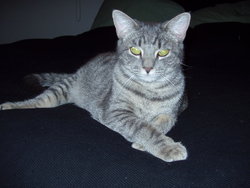Tabby cat
|
|
Longhair_Tabby_JaJa.jpg
Tabby cats are often mistaken as a certain breed of cat. The term tabby actually refers to the stripes, dots and swirling patterns of the cat's coat. The tabby pattern is believed to be the original basic cat pattern, and the closest to their distant ancestors. Tabby coloration is found in many breeds of cat, as well as among the general 'moggy' (mixed-breed or mongrel) population.
The word comes from French tabis, which was earlier atabis, and in medieval Latin attabi. The original origin of the word seems to be from the Attabiyah section of Baghdad where a type of striped silk was made that was later used to describe cats.
Tabby colors and patterns
Tabbies come in every fur coloring possible for cats. As for brown tabbies, the name given to them is misleading because they are actually genetically black. It is possible to have a black, blue, red, cream, chocolate, cinnamon, lilac or fawn. Only the first four are very common and tend to be called brown tabbies, grey or silver tabbies and ginger or marmalade tabbies. The rest of the colors tend to be found among pure bred hybridized for their recessive traits.
The tabby stripes can either take the form of a distinct mackerel or fishbone striping, or they may be more loosely splotched. Alternatively, they may have a spotted coat, which is actually stripes broken up into distinct blotches, or they may be ticked. This is where the hairs have distinct bands of color on them, breaking the tabby patterning up into a salt-and-pepper appearance. The ticked pattern is most dominant, next comes the mackerel tabby and the classic tabby is most recessive of them all. The spotted tabby is not an actual pattern, but a modifier that breaks up the tabby markings. It does not work on ticked tabbies, which have no markings. Tabby patterns with markings all have a base of ticked hairs covered with patterns of solid colored hairs. Therefore, you can tell the base color of a tabby by looking at the stripes instead of the background color.
PICT0060.JPG
Tabby patterns are dominant over all other patterns except for dominant white and bicolor and are very common. It is possible to have a tabby pattern overlaid onto a tortoiseshell pattern. These are loosely called torbies or tabby torties.
Many tabbies have a distinct 'M' marking on their forehead, which is the mark of the true tabby. There are several legends about where this came from, including one that the Virgin Mary bestowed an M on a tabby's head because the cat helped keep the baby Jesus warm.
Almost all tabby cats have a brick red or rose-colored nose and light-colored areas around the eyes and often the chin.
The mackerel tabby was the original pattern of cats, and share a common ancestor with the African wild cat. The spotted tabby soon cropped up and was liked because of its 'wild' look. After that, it is unclear whether classic or ticked came in the most recently.
Myth
There is a myth that tabbies recieved the M-shaped fur of their foreheads after the Virgin Mary placed her hand on a cat in the stable she was in when Jesus was born.
TabbyCat.jpg
External links
- History of the tabby cat (http://www.water-spirit.com/Dragons_Lair/tabby.shtml)
- Tabby coat patterns (http://www.devons.com/tabby.html)

